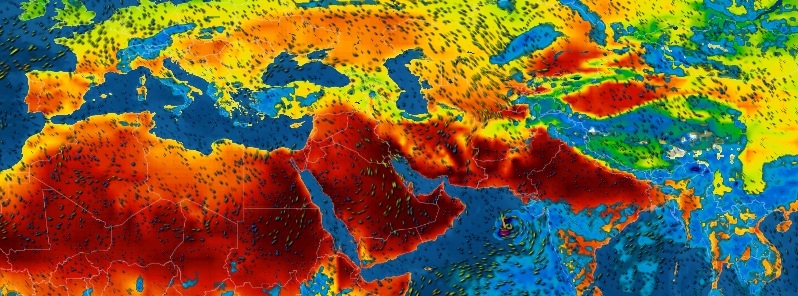Summer of 2015 was officially reported to be Earth’s hottest summer on record; however, if no action is taken to slow down global warming, large parts of the Middle East will be too hot for humans to live in by the year 2090, new research published in the scientific journal Nature Climate Change warns.
Even though the research does not specify the exact impact on North African countries, including Egypt, it is worthy to note that the majority of Egyptian expatriates reside in the Gulf countries. In an interview to al-Watan, secretary-general of the union of Egyptians abroad Amin Ahmed Ali, estimated that among the 10 million Egyptians living abroad, 6.5 million of them are scattered across the Gulf countries – with a majority living in Saudi Arabia.
Scientists previously believed it would be at least 200 years before the climate in countries around the Persian Gulf region would become unlivable for humans. But extreme heat waves – that now occur only once every 20 years – will become “the normal summer day”, Elfatih Eltahir, an engineering professor at the Massachusetts Institute of Technology and co-author of the study, told Bloomberg.
Through computer simulations, the researchers recorded predictions of what the Gulf climate might look like during the last 30 years of the century. Assuming the production of greenhouse gasses continues at its current pace, the process of global warming is consequently anticipated to accelerate.

The results found that before the end of the 21st century, standard temperatures in major cities in the region are expected to exceed 55 degrees Celsius and could reach as high as 60 degrees in Kuwait City. Places like Abu Dhabi, Dubai, Doha and Dhahran will see higher temperatures and humidity levels than anything previously recorded on Earth.
Furthermore, Hajj – the annual pilgrimage that brings millions of Muslims to Saudi Arabia every year – would “become hazardous to human health” when it falls in summer, especially for older travelers. “What we are talking about is significantly more severe than people have experienced anywhere before,” Eltahir claims. The most extreme conditions “would exceed what a human body may be able to tolerate.”
Most of the Gulf countries’ economies are built on oil and gas industries, a primary cause of the greenhouse gasses that are responsible for global warming. But because those countries will also suffer the harshest consequences, it would be in their best interest to try and halt climate change, the authors write.
Most inhabitants of the richer countries in the region, like Saudi Arabia and the United Arab Emirates, will be able to adapt their lifestyles to the heat, but summers will mostly be spent indoors as “even the most basic outdoor activities are likely to be severely impacted”. People in less wealthy countries such as Yemen “will probably suffer both indoors and outdoors.”
During the summer of 2015, the Middle East suffered a severe heatwave, with temperatures peaking at 51 degrees in the southern Iraqi city of Basra. In the Iranian city of Bandar Mahshahr,
the temperature hovered around 46 degrees, but an unfortunate combination of humidity and high temperatures made it feel like it was 76 degrees.
In Egypt, at least 110 people died as temperatures soared to 46 degrees Celcius.






Comments (2)
[…] på 55-60 grader innan 2050, vilket är över gränsen för vad en människa tål. Redan i somras dog hundratals personer under en värmebölja med temperaturer på 45-50 […]
[…] Most recently, the scientific journal Nature Climate Change published a research study warning that the Middle East will be “unlivable” before the turn of the century due to high temperatures if no action is taken to slow down global […]